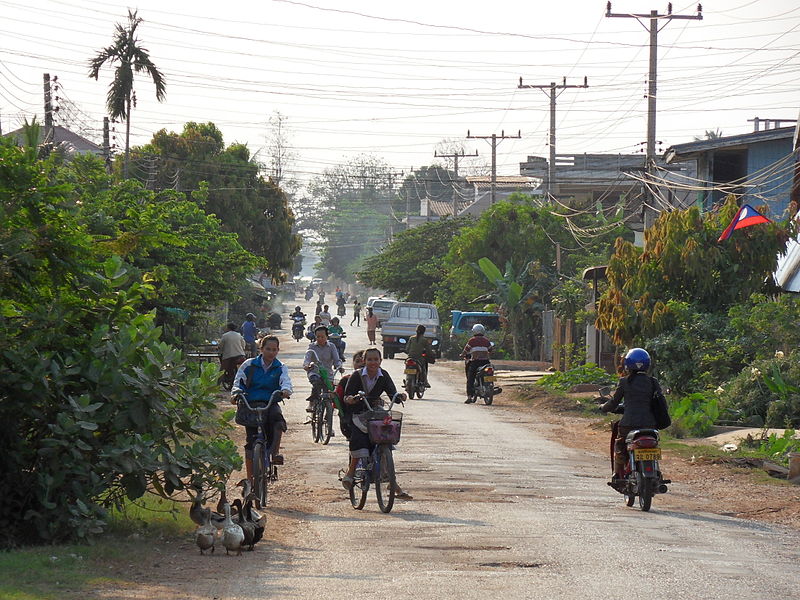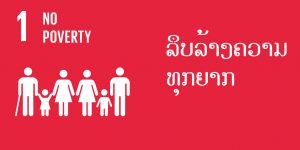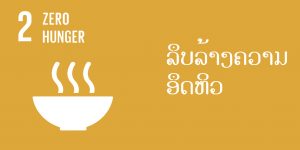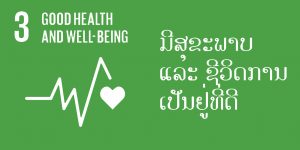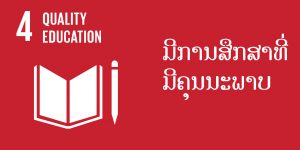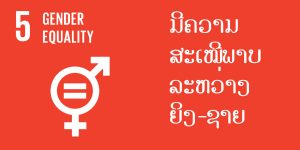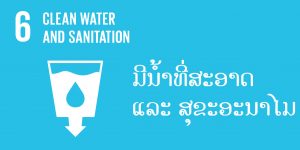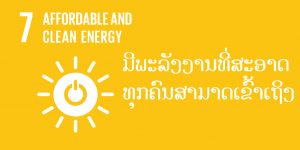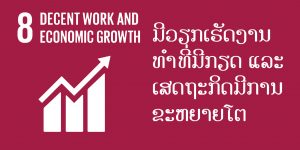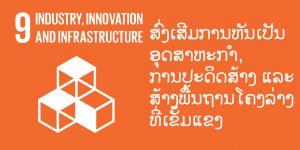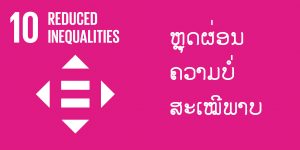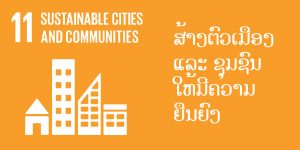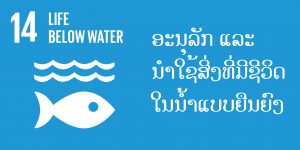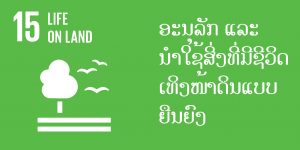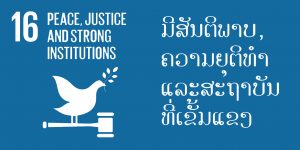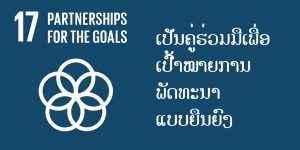In September 2015, the UN General Assembly released the 2030 Agenda for Sustainable Development, including 17 Sustainable Development Goals (SDGs). They were designed to build on the Millennium Development Goals (MDGs)1 and intended to drive action in important areas by 2030, leaving no one behind. These goals were broken down into 169 targets and 232 indicators.2
Unlike the MDGs, the SDGs are intended to apply to all countries, regardless of their level of development. They still maintain the social aims of the previous goals, but now have more focus on the urgent environmental challenges facing the world. As with the MDGs, the Government of Lao PDR will again localise these goals to make them more relevant to the situation in Laos and has already an extra SDG to reduce the impact of remaining land mines (UXOs) in the country.3
Transition from the SDGs to the MDGS in Laos
By the end of 2015, the Lao PDR had used the Millennium Development Agenda to halve poverty, malnourishment, and child mortality rates, as well achieve almost universal primary school enrolment. However, despite meeting targets for eight of the nine local MDGs, none of the goals were met in full.4
Laos had made strong efforts to adapt the MDGs and align them with each National Socio-Economic Development Plans during this time but in many ways this was difficult. For example:
- The estimated yearly cost of implementing the MDGs was almost US $1.3 billion, which is a lot of finance to access.5
- Lao is a low-income, landlocked country, and there are many different ethnic groups who live in remote areas and speak different languages. Because they work mainly in subsistence agriculture, it is a big challenge to improve their development outcomes.6
- The approaches the government used to develop the economy quickly also created negative impacts. In areas where people rely on natural resources, access to health and education is lower, especially for women. Also, rapid growth had not resulted in malnutrition and stunting in children being reduced.7
A street in Savannakhet, Laos. Source: Wikipedia Commons – Chaoborus (own work). GNU Free Documentation License, Version 1.2.
In 2015 and 2016, Laos reflected on these challenges through a national planning process and developed the 8th National Socio-Economic Development Plan (2016 -2020).8 They focused this plan on meeting the Sustainable Development Goals, as well as graduating from Least Developed Country Status by 2020.9
Localization of the SDGs
Lao PDR is one of the fastest growing economies in the East Asia and Pacific region but the growth is unequal and a lot of it is based on the exploitation of natural resources, including hydropower, mining and agro-forestry. This growth has resulted in a rapid loss of forest cover and biodiversity.10
Impacts from climate-related events, such as floods, droughts, and even heavy frosts are much larger in Laos than other countries because there is a large number of people that live in rural areas, who depend on agriculture for their livelihood. Livestock deaths and crop failures, disease outbreaks, and being isolated when roads get damaged make some people economically and socially vulnerable.11
Because Laos was not able to meet all the MDGs and these problems occur, the Government of Laos has showed a lot of interest in making sure the SDGs fit the Laos context more effectively. A National Steering Committee has been used to development national plans to implement the SDGs as quickly as possible. This includes the 8th NSEDP 2016-2020; the Ten Year Development Strategy 2016-2025; and Vision 2030. These plans all are designed to meet SDG Targets and Indicators.12
For example, the 8th NSEDP (2016-2020) is designed to achieve results and 60% of its indicators are very close to the SDGs. Some SDGs are also focused on things that Laos needs for sustainable development like better infrastructure, such as roads internet and phone connections to make it easy to communicate with remote areas and with other countries, as well as making sure rural people can get benefits from economic development.
Laos is making sure that all SDGs take into account local conditions and the government will presented the results of this localization process to the UN High Level Political Forum (HLPF) in mid-2018 as part of a Voluntary National Review. Some of the local factors that have been considered are outlined below for each local SDG.13
Means of Implementation for the SDGs
The 8th NSEDP (2016–2020) aims for Laos to graduate from ‘least developed’ status as it will enable the country to show it is capable of managing types of development finance that are currently more difficult to access. It has outlined these plans in the Vientiane Declaration on Partnership for Effective Development Co-operation (2016-2025).14 The Government of Laos has also completed a Development Finance and Aid Assessment (DFAA) to better understand, which financial resources are best to use to meet the SDG Targets, such as grants, soft loans, or beneficial trade relationships.
This is an issue common to many countries and the Addis Ababa Action Agenda15 is used internationally to show developing countries how to be more strategic when accessing public and private finance to achieve the SDGs while reducing public debt.
It is estimated that the Lao PDR will need USD 27 billion to implement the 8th NSEDP over five years and over half of this will need to come from private investment. If bank lending is included, this rises to more than 75%. Government revenue and Official Development Assistance (ODA) is expected to contribute less than a quarter of these funds. Laos will increasingly need to align its development ambitions with the need of the private sector.16
Lao will need to leverage their own finances with the support of foreign investment to achieve the SDGs, especially for social outcomes in the education and health sectors, which are still heavily reliant on ODA.17
An agreement between the UN and the Government of Laos prioritises18 that for the 10 years after 2015, ODA will focus on four main areas including the Sustainable Development Goals, as well as food and nutrition security; green growth, and climate change and disaster preparedness.19
These priorities are outlined in a country analysis, which was used to development the agreement. This framework for ODA intends to distributing the benefits of development more equitably.20 Donor countries including Australia, the European Union, France, Germany, Japan, the Republic of Korea, Luxembourg, Switzerland and the United States, who will co-ordinate their support to the Lao Government through the UN. The break down for how ODA was applied for 2016 & 2017 is shown in the chart below.21
Chart created by ODL. Source: The United Nations in the Lao PDR. 2017. “2016 Progress Report: United Nations Development Assistance Framework in Lao PDR.”
The ASEAN Community Vision 2025 and other forms of regional or South South co-operation22 will also play a role in Laos meeting the SDGs, particularly for transboundary issues such as the development of hydropower projects or the abatement of greenhouse gas emissions. Regional initiaiitves such as the AIIB, led by China, for example, may complement ODA has a commercial focus of economic co-operation without the conditions attached to loans from other development banks.23 The AIIB is likely to have an influence on how goals related to energy (SDG 7), economic growth (SDG 8), infrastructure (SDG 9), urban development (SDG 11), climate action (SDG 13), as well as development partnerships (SDG 17) are implemented.24
Monitoring and Evaluation of the 2030 Sustainable Development Agenda
For the 8th NSEDP (2016-2020), the Ministry of Planning and Investment and Lao Statistics Bureau have developed a results-based Monitoring and Evaluation Framework, with 60% of its indicators aligned to tracking progress toward the Sustainable Development Goals.
However, the national capacity to implement this framework is limited, and the data required is often unavailable or can be unreliable.25 Currently the Government of Laos collects three types of data to develop its indicators including government administrative data, calculations based on publicly available data, as well as data taken from international agencies.26
The monitoring and evaluation framework needed to balance the affordability of different types of data collection methods with the government budget and it will be focused on meeting localised goals rather than the Global Goals. In many cases it was required to be pragmatic and choose indicators based on how easy they are to measure rather than their outcomes. These decisions were made to ensure that support to collect data was sustainable and appropriate for Lao’s institutional capacity.27
One approach the Government of Laos is taking is to upgrade the Lao Social Indicator Survey (LSIS). This is a nation-wide household survey, which will now generate data across all 18 provinces, disaggregated by age, residence, gender, wealth and ethnicity. It will provide baseline data for the 8th NSEDP and the SDGs. It will be used to influence how the Government of Lao sets policies and prioritizes resources for meeting the SDGs in a way that benefits all citizens.28
Related to the Sustainable Development Goals
- Sustainable Development Goals (Mekong)
- Sustainable Development Goals (Cambodia)
- Sustainable Development Goals (Myanmar)
- Sustainable Development Goals (Thailand)
- Sustainable Development Goals (Vietnam)
References
- 1. The United Nations in the Lao PDR. “MDGs in the Lao PDR.” Accessed May 2018.
- 2. United Nations. 2015. “Transforming Our World: The 2030 Agenda For Sustainable Development.” Accessed March 2018.
- 3. UN System Task Team. 2012. “Review of the contributions of the MDG Agenda to foster development: lessons for the post-2015 UN Development Agenda.” Accessed March 2018.
- 4. UN in the Lao PDR. 2017. “From Millennium Development Goals to Sustainable Development Goals: Laying the base for 2030.” Accessed March 2018.
- 5. Outhavong, P. (2014). “MDGs Localization in Lao PDR.” Accessed May 2018.
- 6. UNDAF. 2012. “UNDAF Action Plan 2012-2015: Lao PDR.” Accessed May 2018.
- 7. UNDP. 2016. “Transitioning from the MDGs to the SDGs.” Accessed May 2018.
- 8. Ministry of Planning and Investment. 2016. “8th Five-Year National Socio-Economic Development Plan.” Accessed May 2018.
- 9. UN in the Lao PDR. 2017. “From Millennium Development Goals to Sustainable Development Goals: Laying the base for 2030.” Accessed March 2018.
- 10. The United Nations in the Lao PDR. 2017. “2016 Progress Report: United Nations Development Assistance Framework in Lao PDR.” Accessed May 2018.
- 11. Ibid.
- 12. ASEAN Ministers Workshop on the Sustainable Development Goals. 2017. “Remarks by the Minister of Foreign Affairs of the Lao PDR.” Accessed May 2018.
- 13. UN in the Lao PDR. 2017. “From Millennium Development Goals to Sustainable Development Goals: Laying the base for 2030.” Accessed March 2018.
- 14. Government of the Lao PDR. 2016. “Vientiane Declaration on Partnership for Effective Development Co-operation (2016-2025).” Accessed May 2018.
- 15. United Nations. 2015. “Addis Ababa Action Agenda of the Third International Conference on Financing for Development.” Accessed May 2018.
- 16. Ministry of Planning and Investment. 2016. “Development Finance for the 8th National Socio-Economic Development Plan and the Sustainable Development Goals in Lao PDR: A Development Finance and Aid Assessment.” Accessed May 2018.
- 17. ASEAN Ministers Workshop on the Sustainable Development Goals. 2017. “Remarks by the Minister of Foreign Affairs of the Lao PDR.” Accessed May 2018.
- 18. The United Nations in the Lao PDR. 2016. “Lao PDR–United Nations Partnership Framework (2017-2021): A Partnership for Sustainable Development.” Accessed May 2018.
- 19. The United Nations in the Lao PDR. 2017. “2016 Progress Report: United Nations Development Assistance Framework in Lao PDR.” Accessed May 2018.
- 20. The United Nations in the Lao PDR. 2015. “Country Analysis Report: Lao PDR – Analysis to inform the Lao People Democratic Republic United Nations Partnership Framework (2017-2021).” Accessed May 2018.
- 21. The United Nations in the Lao PDR. 2017. “2016 Progress Report: United Nations Development Assistance Framework in Lao PDR.” Accessed May 2018.
- 22. UNDP. 2016. “Scaling up South-South Cooperation for Sustainable Development.” Accessed May 2018.
- 23. Renwick, N. 2016. “China as a Development Actor in South East Asia.” Accessed March 2018.
- 24. Ministry of Foreign Affairs of Denmark. 2018. “Draft Strategy for Denmark’s Cooperation with the Asian Infrastructure Investment Bank.” Accessed May 2018.
- 25. The United Nations in Laos. 2017. “2016 Progress Report: United Nations Development Assistance Framework in Lao PDR.” Accessed May 2018.
- 26. UN in the Lao PDR. 2017. “From Millennium Development Goals to Sustainable Development Goals: Laying the base for 2030.” Accessed March 2018.
- 27. The United Nations in the Lao PDR. 2017. “Tracking Progress Towards the National Development Goals and the Sustainable Development Goals.” Accessed May 2018.
- 28. UNICEF. 2016. “2017 Lao Social Indicator Survey II to Provide Data for the SDGs.” Accessed May 2018.
